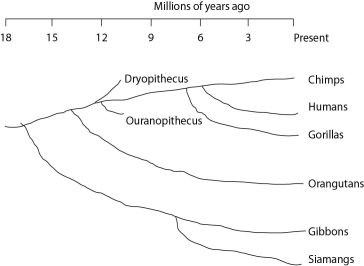Multiple Choice
 Figure 20.4 Humans, chimpanzees, gorillas, and orangutans are members of a clade called the great apes, which shared a common ancestor about 18 million years ago. Gibbons and siamangs comprise a clade called the lesser apes. Tree-branch lengths indicate elapsed time.
Figure 20.4 Humans, chimpanzees, gorillas, and orangutans are members of a clade called the great apes, which shared a common ancestor about 18 million years ago. Gibbons and siamangs comprise a clade called the lesser apes. Tree-branch lengths indicate elapsed time.
-Assuming chimps and gorillas are humans' closest relatives, removing humans from the great ape clade and placing them in a different clade has the effect of making the phylogenetic tree of the great apes
A) polyphyletic.
B) paraphyletic.
C) monophyletic.
D) conform with Linnaeus's view of great ape phylogeny.
Correct Answer:

Verified
Correct Answer:
Verified
Q1: The next questions refer to Table 20.1,
Q1: Cladograms (a type of phylogenetic tree)constructed from
Q5: Three living species X, Y, and Z
Q10: The following questions refer to the phylogenetic
Q16: When using a cladistic approach to systematics,
Q17: There is some evidence that reptiles called
Q22: Linnaeus was a "fixist" who believed that
Q59: When it acts upon a gene, which
Q63: Which eukaryotic kingdom is polyphyletic, and therefore
Q67: If you were using cladistics to build